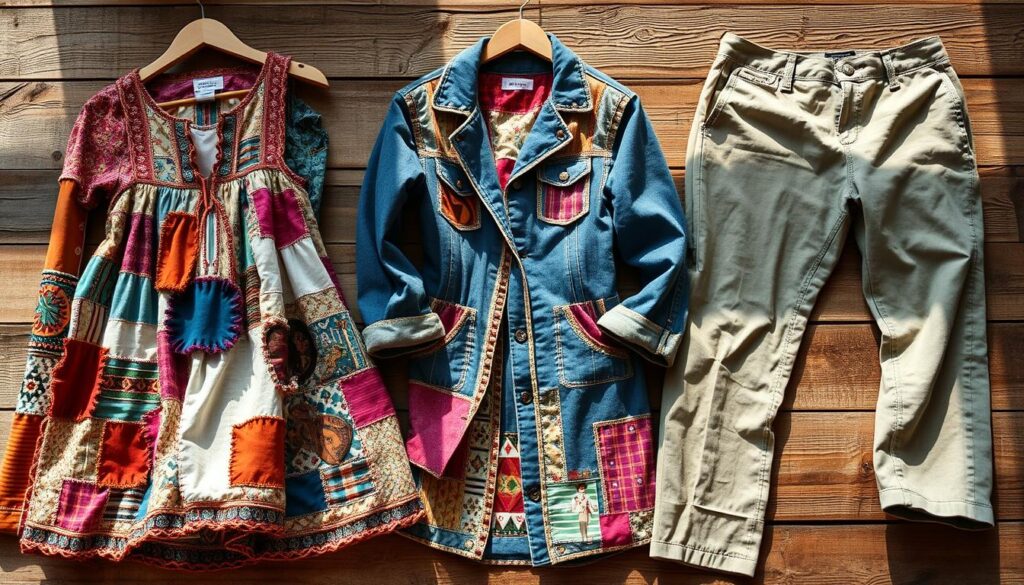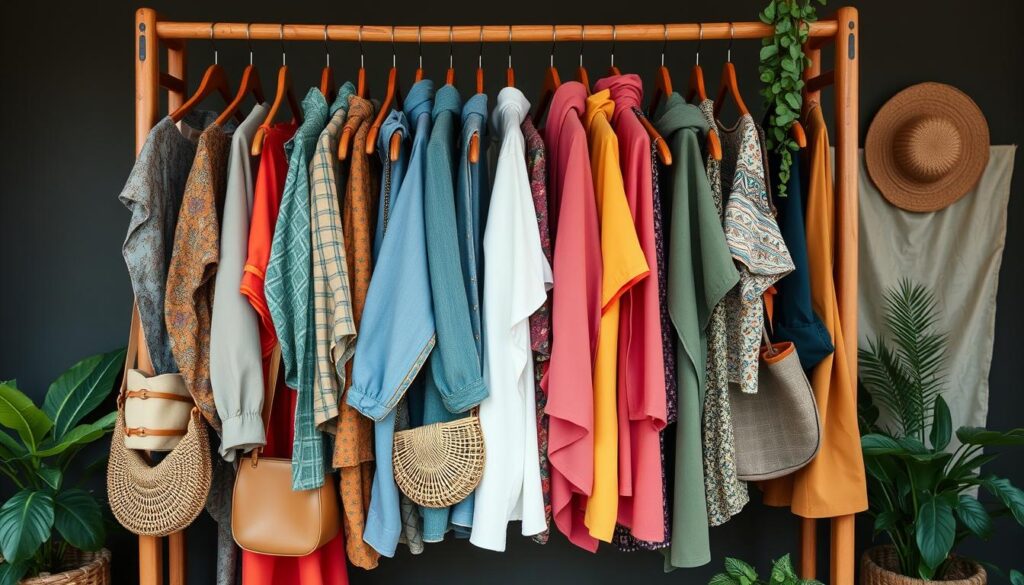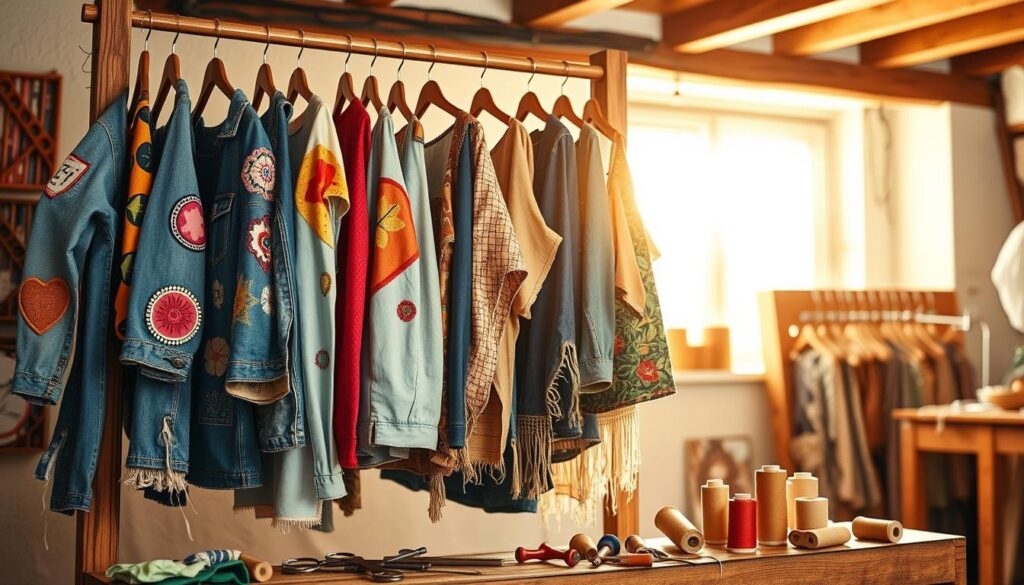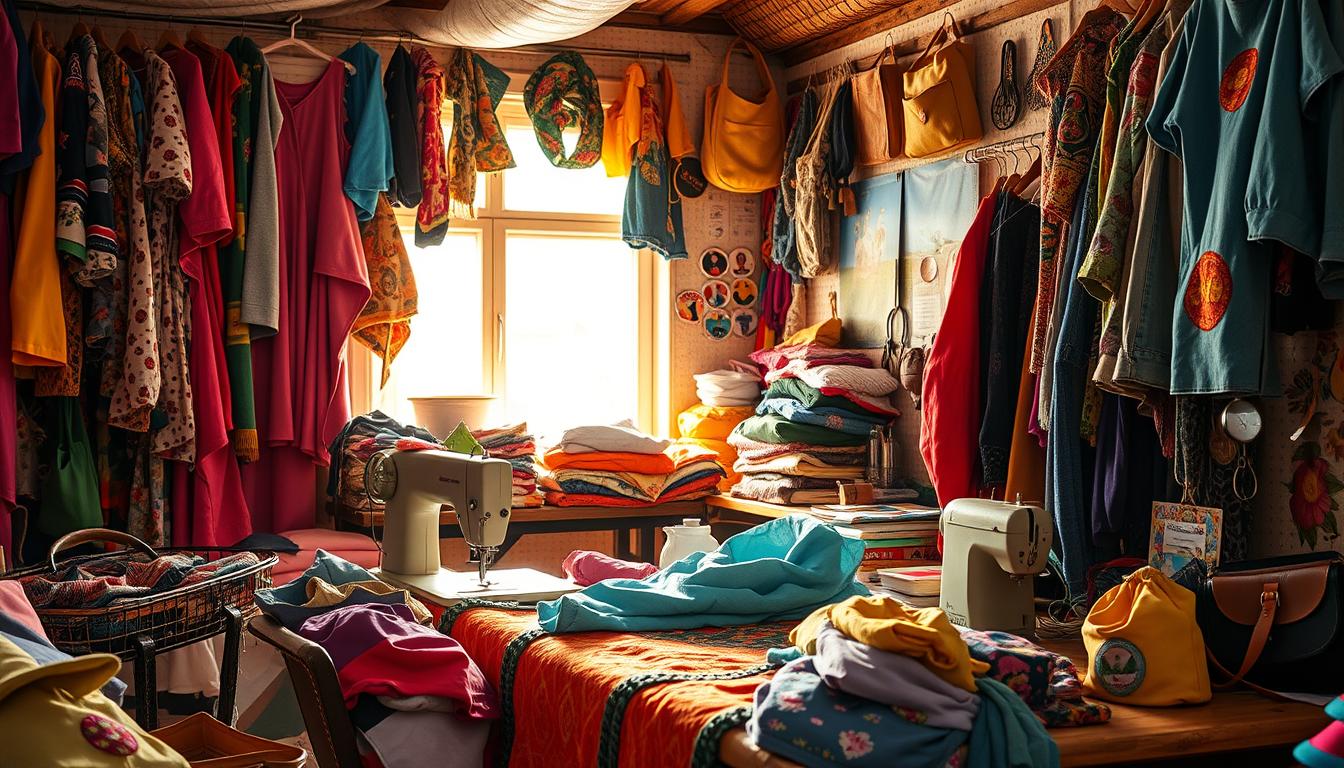Upcycling old clothes for a sustainable wardrobe. In today’s fast-paced fashion landscape, where trends come and go, have you ever wondered about the true cost of your wardrobe? The staggering environmental impact of the industry has sparked a growing movement: upcycling. This innovative approach transforms old garments into unique, personalized pieces, reducing waste and promoting sustainability.
Upcycling is more than just a eco-friendly fashion hack – it’s a celebration of creativity and individuality. By repurposing existing clothes, you can create a wardrobe that reflects your style while minimizing your carbon footprint. But what makes upcycling different from recycling, and how can you get started on your sustainable fashion journey?
Key Takeaways
- Upcycling old clothes reduces textile waste and environmental impact
- It offers a creative and cost-effective way to build a sustainable wardrobe
- Upcycling techniques range from simple modifications to complete garment transformations
- Upcycling fosters a more mindful approach to fashion consumption
- Upcycling supports a circular economy by diverting textile waste from landfills
Understanding Fast Fashion’s Environmental Impact
The fashion industry’s environmental footprint is alarmingly large. Fast fashion, with its relentless demand for new trends and mass production, is a significant contributor to global pollution. In fact, the industry is responsible for about 10% of global carbon emissions, more than all international flights and maritime shipping combined.
The True Cost of Textile Waste
The true cost of fast fashion extends far beyond carbon emissions. Each year, an estimated 92 million tons of textile waste are generated globally, with much of it ending up in landfills or being incinerated, releasing harmful chemicals and greenhouse gases. Additionally, the water used in textile dyeing and finishing is enough to fill 2 million Olympic-sized swimming pools annually.
Global Fashion Industry Statistics
The fashion industry’s environmental impact is staggering. Fashion production comprises 10% of total global carbon emissions, equivalent to the European Union’s total emissions. Moreover, 35% of all microplastics in the ocean come from the laundering of synthetic textiles, and 85% of all textiles end up in landfills each year.
Environmental Consequences of Fast Fashion
The consequences of fast fashion go beyond just environmental concerns. The industry also raises ethical issues, with some labor practices described as “slave labor” by the European Parliament. The 2013 factory collapse in Dhaka, Bangladesh, which resulted in the death of 1,134 workers, highlighted the grim realities of the fashion industry’s supply chain.
These alarming statistics underline the urgent need for a more sustainable approach to fashion, such as repurposing garments, embracing clothing upcycling ideas, and adopting zero-waste wardrobing practices. The fashion industry must take responsibility for its environmental and social impact, and consumers can play a vital role in driving this change.
“Slow fashion advocates for manufacturing that respects people, the environment, and animals.”
What Makes Upcycling Different from Recycling
In the world of sustainable fashion, upcycling and recycling are two distinct approaches that offer unique benefits. While both aim to reduce textile waste, the key difference lies in their underlying processes and the value they create.
Upcycling is the art of transforming discarded materials into products of higher quality or value. In the fashion industry, upcycling involves reimagining unwanted garments into stylish, one-of-a-kind pieces without breaking down the original materials. This concept dates back centuries, but it gained significant popularity in the late 20th century as a response to the environmental impact of fast fashion. Pioneers like Katharine Hamnett have been at the forefront of the upcycled fashion movement, incorporating vintage fabrics into their unique designs.
On the other hand, recycling in the fashion industry primarily focuses on breaking down high-grade materials into their purest forms, such as turning old clothing into new fibers. This process, known as textile recycling, can be resource-intensive and may not always result in the same quality as the original materials. However, recycling initiatives like take-back schemes, where customers can return their old clothes, and the use of regenerated materials like ECONYL® Nylon (made from fishing nets and old carpets) demonstrate the industry’s efforts to reduce waste.
While both upcycling and recycling contribute to a more sustainable fashion ecosystem, the key difference lies in their approach. Upcycling enhances or transforms materials for a different or more valuable purpose, whereas recycling reintroduces materials back into the market after deconstructing them. Ultimately, both practices play a crucial role in minimizing landfill waste, reducing new material production, and promoting a circular economy in the fashion industry.
Studies show that upcycling can reduce carbon emissions by 4-25% compared to purchasing new clothing items, making it a valuable sustainable practice. Moreover, the tradition of upcycling clothing dates back centuries, with denim being a prime example of a historic upcycled textile used since at least 1159 in France.
As the fashion industry continues to grapple with the environmental consequences of fast fashion, the debate surrounding the impact of upcycling and recycling remains an important discussion. Both practices contribute to reducing textile waste, conserving energy, and promoting material reutilization, ultimately shaping a more sustainable future for the industry and the planet.
Essential Tools and Materials for Clothes Upcycling
Embarking on a journey of DIY upcycled outfits can be an incredibly rewarding experience, allowing you to transform old clothes into unique and sustainable fashion pieces. To ensure your upcycling projects are a success, it’s essential to have the right tools and materials at your fingertips. From basic sewing equipment to additional creative supplies, let’s explore the essentials for clothes upcycling.
Basic Sewing Equipment
At the core of any upcycling endeavor is a reliable sewing machine. Whether you’re a seasoned seamstress or a beginner, a quality sewing machine will be your best friend in breathing new life into old garments. Alongside the sewing machine, you’ll need a sharp pair of scissors, a selection of needles, and high-quality threads in a variety of colors to handle different fabrics and projects.
Additional Creative Supplies
- Fabric scraps, patches, and trims to add unique touches to your upcycled pieces
- Textile paints, dyes, and markers to experiment with custom color palettes
- Buttons, zippers, and other embellishments to elevate your upcycled designs
- Tailor’s chalk and fabric marking pens to ensure precise measurements and cutting
Workspace Organization Tips
Maintaining a well-organized workspace is key to the success of your upcycling projects. Invest in storage solutions, such as shelves or drawers, to neatly arrange your sewing equipment, fabrics, and trims. Keeping your workspace tidy will not only improve your efficiency but also foster a creative environment for your DIY upcycled outfits.
Remember, the beauty of upcycling lies in the intersection of creativity, sustainability, and personal expression. By equipping yourself with the right tools and materials, you’ll be on your way to crafting one-of-a-kind clothing that celebrates the unique potential of upcycling old clothes for a sustainable wardrobe.
Upcycling Old Clothes for a Sustainable Wardrobe
As the fashion industry grapples with its environmental impact, upcycling old clothes has emerged as a practical and creative solution. Repurposing garments allows for a thrifted style transformation, where shirts become off-shoulder tops, jeans transform into chic skirts, and dresses are reborn as two-piece outfits. The process often requires only basic sewing skills and a touch of imagination, making it accessible to fashion enthusiasts of all levels.
Upcycling not only reduces textile waste but also enables the personalization of clothing, resulting in truly unique pieces. It’s a cost-effective way to refresh your wardrobe while embracing a more sustainable approach to fashion. By embracing upcycled clothing patterns, you can minimize your carbon footprint and contribute to a circular economy.
“Upcycled fashion promotes a shift towards a circular economy, reducing the demand for new resources such as water and energy, and contributing to local economic development by supporting small businesses and artisans.”
The benefits of upcycling go beyond just the environmental impact. It can also save you money by repurposing existing items instead of purchasing new ones. Additionally, repurposing garments can be a rewarding creative outlet, allowing you to express your personal style in an innovative and sustainable way.
Whether you’re a seasoned seamstress or a beginner in the world of fashion, thrifted style transformation offers endless possibilities. Embrace your inner designer and unlock the potential of your wardrobe through the art of upcycling.

| Key Benefits of Upcycling Old Clothes | Statistics |
|---|---|
|
|
Creative Transformation Techniques for Different Garments
Upcycling old clothes is a fantastic way to breathe new life into your wardrobe while reducing fashion’s environmental impact. From transforming simple t-shirts to reinventing classic denim, the possibilities for creative DIY upcycled outfits are endless.
T-shirt Transformations
One of the easiest and most popular upcycling ideas is to repurpose old t-shirts. You can turn them into stylish crop tops, add contrasting pockets, or even transform them into chic halter or off-the-shoulder tops. With a few snips and stitches, your tired tees can become the centerpiece of your DIY upcycled outfits.
Denim Reinvention Ideas
Denim is another versatile material for clothing upcycling tutorials. Old jeans can be cut and stitched into trendy mini skirts, or the fabric can be used to create unique denim vests or bags. Upcycling denim allows you to give new life to those well-worn pieces while adding a personalized touch to your sustainable wardrobe.
Dress Modifications
Upcycling dresses opens up a world of creative possibilities. You can transform a maxi dress into a chic midi skirt, or take a button-down dress and turn it into a stylish blouse or even a jumpsuit. With a little imagination and some sewing skills, your old dresses can become the foundation for truly one-of-a-kind DIY upcycled outfits.
The key to successful clothing upcycling is to approach it with an open mind and a spirit of experimentation. Explore thrift stores and flea markets for unique secondhand treasures, and let your creativity shine as you breathe new life into old garments. By embracing the art of upcycling, you can build a sustainable wardrobe that reflects your personal style and helps reduce fashion’s environmental footprint.
Building a Sustainable Capsule Wardrobe Through Upcycling
In the quest for a more eco-friendly and intentional approach to fashion, creating a sustainable capsule wardrobe through upcycling has emerged as a transformative solution. By choosing versatile, long-lasting pieces that can be effortlessly mixed and matched, this approach reduces the need for constant new purchases while still providing a variety of outfit options.
Upcycling, the art of transforming existing materials into new and improved products, allows for the creation of timeless designs from items already in your closet. This promotes a more thoughtful and sustainable fashion consumption, as it breathes new life into old clothes and minimizes textile waste.
To build a sustainable capsule wardrobe through upcycling, consider the following tips:
- Declutter your closet and sort clothing items into toss, donate, and recycle categories to identify the essentials that can be repurposed.
- Choose natural fiber clothing made from materials like cotton, linen, or wool, as they are more durable, biodegradable, and comfortable.
- Incorporate accent pieces like handmade jewelry, scarves, or hats to add freshness and variety to your capsule wardrobe without compromising its minimalist essence.
- Maintain your upcycled garments by making repairs, carefully storing them, and following the recommended washing guidelines.
- Consider themed capsule wardrobes, such as by purpose (working from home, traveling, formal), color (neutral, warm, cool tones), or season, to provide a structured approach to outfit selection.
By embracing the principles of zero-waste wardrobing, sustainable clothing hacks, and eco-friendly fashion, you can curate a versatile and intentional closet that aligns with your personal style and environmental values. Investing in quality, timeless pieces and leveraging the power of upcycling can transform your wardrobe into a more sustainable and visually appealing reflection of your lifestyle.

The fashion industry is one of the largest polluters globally, but by adopting a sustainable capsule wardrobe approach, you can make a meaningful impact on reducing waste and promoting a more ethical and environmentally conscious fashion industry.
“Sustainable fashion isn’t just about what you buy, it’s about how you build and care for your wardrobe. Upcycling is a game-changer in creating a truly zero-waste closet.”
Advanced Upcycling Projects and Design Ideas
Embracing the art of upcycling takes sustainable fashion to new heights. Beyond the basics of transforming old clothes into fresh, one-of-a-kind pieces, advanced projects offer endless opportunities for creativity and style. From statement-making patchwork jumpers to Regency-inspired bustiers, the possibilities are truly limitless when it comes to upcycled clothing patterns.
Statement Piece Creations
Elevate your wardrobe with statement pieces that showcase your unique style and sustainable sensibilities. Experiment with bold color combinations, intricate embroidery, or unexpected fabric pairings to craft truly remarkable garments. Upcycling allows you to infuse each piece with your personal flair, creating conversation-starting looks that are as fashionable as they are eco-friendly.
Seasonal Wardrobe Updates
Extend the life of your clothing by reimagining winter essentials for summer and vice versa. Transform cozy sweaters into breezy tank tops, or give new life to dresses by adding playful peplum details. Upcycling encourages a more thoughtful approach to your seasonal wardrobe, reducing waste while keeping your style fresh and on-trend.
Accessory Making Tips
- Repurpose scarves into chic beach cover-ups or stylish headbands
- Create trendy scrunchies from fabric scraps for a zero-waste hairstyle solution
- Upcycle old belts into unique bag straps or playful chokers
Accessory-making is the perfect entry point for beginner upcyclers, allowing you to experiment with different materials and techniques. These small-scale projects also make thoughtful, sustainable gifts for friends and family.
The world of advanced upcycling projects invites you to push the boundaries of creativity and fashion. By embracing innovative techniques and materials, you can transform your wardrobe into a sustainable showcase of your personal style. Whether you’re crafting statement pieces, seasonal updates, or chic accessories, the joy of upcycling lies in the process of bringing new life to old garments.
| Technique | Benefits |
|---|---|
| Zero-waste pattern-making | Minimizes fabric waste by utilizing every inch efficiently |
| Made-to-measure programs | Reduces overproduction and inventory waste |
| Seamless knit technology | Eliminates the need for cutting and sewing, reducing waste |
| Multifunctional garments | Extends the lifespan and usability of each piece |
| Rental services | Offers a practical solution for reducing waste and meeting consumer needs |
Maintaining and Caring for Upcycled Garments
As you embark on your sustainable clothing journey through upcycling, proper care and maintenance of your transformed garments is crucial. By ensuring your upcycled pieces receive the right attention, you can extend their lifespan and keep your eco-friendly wardrobe looking its best.
Washing and Storing Upcycled Clothing
When it comes to washing upcycled items, it’s important to follow the care instructions carefully. Opt for gentle, eco-friendly detergents and avoid high-heat drying, which can damage delicate fabrics. Store your upcycled clothes in a cool, dry place, away from direct sunlight, to prevent fading and wear. Consider investing in garment bags or boxes to further protect your sustainable fashion pieces.
Extending the Life of Upcycled Garments
- Embrace the art of visible mending: Use colorful threads, patches, or embroidery to repair any tears or wear and tear, transforming your upcycled item into a unique, one-of-a-kind piece.
- Learn essential sewing techniques: Master skills like backstitch, running stitch, and blanket stitch to quickly and easily fix any issues that may arise with your upcycled clothing.
- Explore no-sew solutions: Utilize fabric glue, iron-on patches, or DIY dye to breathe new life into your upcycled garments without the need for a needle and thread.
By following these sustainable clothing hacks, you can ensure your upcycled fashion items remain eco-friendly, stylish, and long-lasting, contributing to a more sustainable wardrobe that reduces textile waste.

“The true cost of fashion is paid by the planet and its people. Upcycling offers a way to reduce that burden and create something unique and beautiful in the process.”
The Business Side of Upcycled Fashion
As the demand for sustainable fashion continues to grow, the upcycled clothing industry is emerging as a promising avenue for entrepreneurship and innovation. Upcycling, the process of transforming discarded garments into unique, high-quality pieces, offers both creative and economic opportunities for fashion-forward individuals and businesses.
Navigating the legal and regulatory aspects of an upcycled fashion business is crucial. Ensuring compliance with safety standards, labeling requirements, and intellectual property laws is essential to operate a successful and ethical enterprise. Additionally, understanding the market demand for upcycled clothing patterns, thrifted style transformation, and eco-friendly fashion is crucial for driving sales and building a loyal customer base.
| Statistic | Data Point |
|---|---|
| Global fashion industry generates | 92 million tons of textile waste annually |
| Only 1% of clothing waste is globally recycled | |
| Estimated that 25-40% of fabric used in garment production is wasted | |
| Upcycling can potentially upcycle at least 50% of textile waste into new clothing | |
| The number of upcycling companies in the Netherlands has shown significant growth, increasing from at least seven in 2013 to at least 140 in 2023 | |
| Around 50% of collections from the Paris-based fashion brand Marine Serre are composed of upcycled products |
Upcycling businesses can support local economies by creating job opportunities and fostering a sense of community among those passionate about sustainability and creativity. Moreover, these enterprises promote innovation in design, raise awareness about sustainable fashion practices, and offer consumers unique, eco-friendly alternatives to fast fashion.
As the upcycled clothing patterns, thrifted style transformation, and eco-friendly fashion trends continue to gain momentum, the potential for successful upcycled fashion businesses is undeniable. By embracing the principles of sustainability and creativity, entrepreneurs can carve out their niche in this burgeoning industry and contribute to a more sustainable future for the fashion world.
Conclusion
Upcycling old clothes offers a creative and sustainable solution to the environmental impact of fast fashion. By embracing this practice, individuals can contribute to a more ethical and eco-friendly fashion industry while expressing their unique personal style. The techniques explored in this article, from simple t-shirt transformations to advanced design projects, demonstrate the boundless possibilities of upcycling.
As consumers become increasingly aware of the negative consequences of fast fashion, the demand for sustainable clothing options continues to grow. Upcycling not only reduces waste but also conserves valuable resources, such as water, energy, and raw materials. By supporting brands that prioritize sustainability and adopting upcycling as a lifestyle, we can collectively drive the shift towards a circular fashion economy.
The journey of upcycling old clothes is not just a passing trend but a meaningful step towards a more sustainable future. Whether you’re a seasoned crafter or a beginner, the art of transforming unwanted garments into unique and personalized pieces can be both rewarding and empowering. By embracing the principles of upcycling, we can create a more thoughtful and eco-friendly wardrobe while contributing to the larger movement towards a more sustainable fashion industry.
FAQ
What is upcycling and how does it differ from recycling?
How does fast fashion impact the environment?
What essential tools and materials are needed for clothes upcycling?
What are some examples of upcycling old clothes into new styles?
How can upcycling help build a sustainable capsule wardrobe?
What are some advanced upcycling projects and design ideas?
How can I properly care for and maintain my upcycled garments?
Can I turn upcycling into a business opportunity?
Source Links
- https://www.gathered.how/arts-crafts/upcycling-clothes-ideas
- https://secondlifeupcycling.com/clothes-upcycling-ideas/
- https://www.chitkara.edu.in/blogs/upcycling-and-diy-fashion-redesigning-and-repurposing-clothes-for-a-sustainable-wardrobe/
- https://earth.org/fast-fashions-detrimental-effect-on-the-environment/
- https://dwijproducts.com/blogs/dwijblogs/the-power-of-upcycling-clothes-sole-savior-of-the-fashion-industry
- https://stateofmatterapparel.com/blogs/som-blog/upcycling-vs-recycling-and-why-it-matters?srsltid=AfmBOorufm9_a6aCoy45UxXif_1VCkTbzo9MkUNQfDNSMLgCXZwyYiTb
- https://shoprestatement.com/blog/is-upcycling-clothing-worth-it-upcyclings-true-impact-on-the-environment/
- https://pomp.store/blogs/journal/upcycling-vs-recycling-vs-downcycling-in-fashion?srsltid=AfmBOopXK-TFfcag48GeMMte0uhFtsxJovtfzVgnYB75eSEuWokDmGAY
- https://www.rockandart.org/fashion-upcycling-staples/
- https://greensuggest.com/9-tools-you-need-to-start-upcycling-your-clothes/
- https://sustainablereview.com/11-easy-diy-tricks-to-transform-your-wardrobe-with-upcycled-fashion/
- https://www.plenty.com/en/family-life/upcycling-clothes-how-to-upcycle-clothes-and-give-them-a-second-life/
- https://talu.earth/upcycling-clothes-ideas/
- https://www.econyl.com/magazine/social-community/a-beginners-guide-to-upcycling/
- https://secondlifeupcycling.com/upcycle-clothes/
- https://www.easthillscasuals.com/blogs/news/transform-your-wardrobe-with-low-impact-fashion?srsltid=AfmBOorGVm-p8zezCngjvIMcWGcECnqbmfUb39RzZjQJirFu0J1BcxLx
- https://www.wearehoneymilk.com/blog/how-to-build-a-sustainable-capsule-wardrobe
- https://greatergoodeco.com/build-eco-friendly-wardrobe-without-compromising-style
- https://www.fittdesign.com/blog/sustainable-fashion-six-innovative-practices-for-fashion-brands-to-reduce-waste-and-boost-sustainability?srsltid=AfmBOoraiTbhOMNyWH_Gbta4hcWgI0YUwZfQklxxmxg5gMDKXmKcgf9h
- https://shopduer.com/blogs/uncuffed/what-to-do-with-old-jeans-5-creative-upcycling-ideas?srsltid=AfmBOortldDZ-HLtaGybn7HbjO7Hp_eAO_61ug8QHR229WgyIvGDiH9u
- https://www.sustainablejungle.com/upcycling-clothes/
- https://www.rd.com/article/upcycle-clothes/
- https://www.sustainablejungle.com/upcycled-clothing/
- https://fashionunited.com/news/background/making-something-new-from-something-existing-is-in-this-is-upcycling/2024010857698
- https://fashinnovation.nyc/sustainable-fashion-trend/
- https://www.bankvogue.com/from-waste-to-wardrobe-the-journey-of-recycled-textiles/
- https://shoprestatement.com/blog/upcycling-clothes-10-ways-on-how-to-upcycle/
- https://www.fibre2fashion.com/industry-article/10079/towards-a-greener-wardrobe-the-path-to-sustainable-fashion





